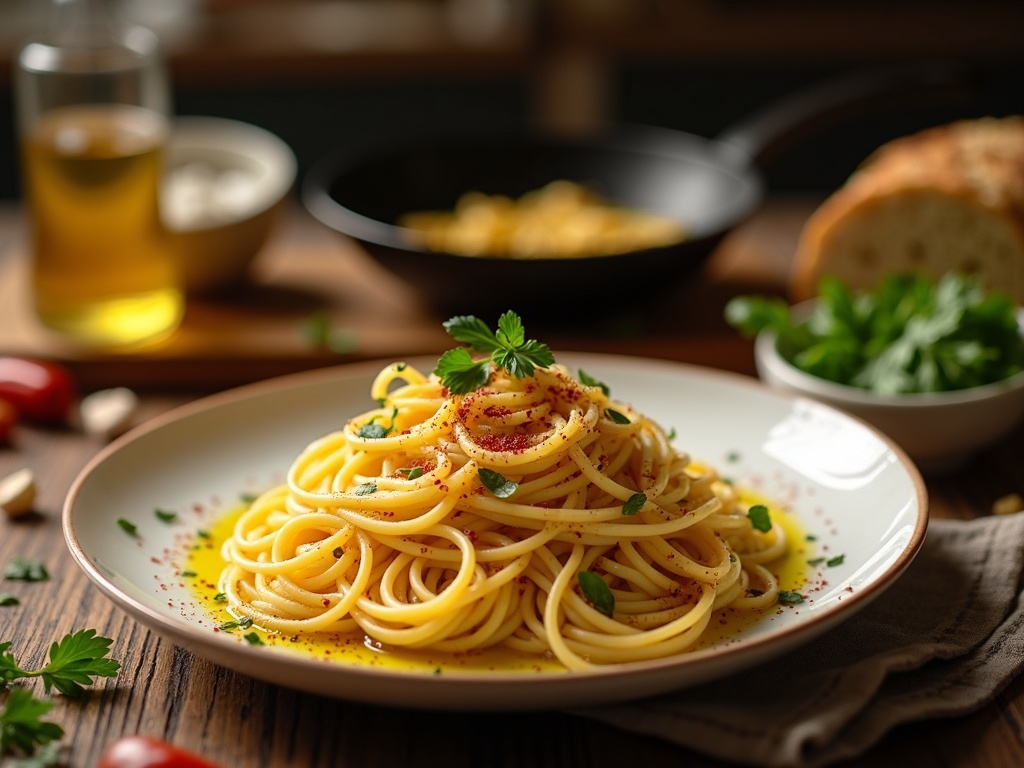Aglio olio recipe, a culinary gem from Naples, captures the Italian principle of letting simple ingredients shine with minimal handling, creating perfect harmony using just garlic and olive oil. This pasta dish comes together in only 20 minutes, serving as both an impressive quick dinner and a genuine test of pasta expertise that honors quality ingredients over fancy methods.
Find In This Article
Key Takeaways
- The perfect aglio olio requires quality ingredients including bronze-die extruded pasta, fresh garlic sliced rather than minced, and cold-pressed olive oil in a precise ratio of 100ml oil to 400g pasta.
- Proper technique involves cooking pasta al dente, sautéing garlic until golden but not brown, and using reserved pasta water to create a silky emulsion that coats each strand.
- While traditional aglio olio is beautifully simple, it serves as an excellent canvas for variations including seafood additions, protein options like chicken, or vegetable enhancements.
- The dish offers a balanced nutritional profile with heart-healthy monounsaturated fats from olive oil, sustained energy from carbohydrates, and a modest protein content.
- Serving aglio olio in pre-warmed bowls maintains optimal temperature and aroma, while complementary sides like crisp salads create a perfect contrast to the rich, garlicky pasta.
What Makes Aglio Olio recipe Special
Aglio olio stands as one of the most beautifully simple Italian pasta creations, originating from the streets of Naples. I’ve found that this dish perfectly captures the Italian cooking philosophy: quality ingredients handled with minimal interference. The name itself translates to “garlic and oil” – the two star ingredients that form its flavorful base.
Perfect Simplicity in Every Bite
What truly sets aglio olio apart is its remarkable balance of flavors achieved with just a handful of ingredients. The aromatic marriage of golden-toasted garlic and high-quality olive oil creates a silky coating for the pasta that’s both rich and light. Unlike many pasta dishes that rely on heavy sauces, creamy pasta variations, or complex ingredient lists, aglio olio celebrates simplicity.
The beauty lies in its versatility too. I can easily prepare this dish in about 20 minutes, making it perfect for busy weeknights or as an impressive last-minute dinner option. Many Italian chefs consider it the ultimate test of pasta cooking skill – with so few elements, each must be executed perfectly.
From Humble Origins to Global Favorite
Aglio olio’s appeal extends far beyond its Italian roots. What began as humble sustenance has evolved into a globally beloved dish served in both casual and fine dining settings. The dish often features as a late-night comfort food in Italy, offering satisfaction without overwhelming the palate.
While the classic version requires only pasta, olive oil, garlic, chili flakes, and parsley, many modern adaptations exist. Some chefs add a sprinkle of broccoli to pasta for added nutrition, while others might introduce lemon zest for brightness or top with toasted breadcrumbs for texture.
I find that aglio olio pairs wonderfully with a variety of proteins too – from grilled chicken to seafood – making it adaptable to different dietary preferences. When compared to more complex dishes like puttanesca or chicken carbonara, aglio olio offers a cleaner flavor profile that lets each ingredient shine.
Its enduring popularity comes from this perfect balance – sophisticated enough for special occasions yet simple enough for everyday meals. For pasta lovers seeking authentic Italian flavors without complicated techniques, aglio olio delivers satisfaction in every forkful.
Essential Ingredients and Why They Matter
I’ve found that the true magic of aglio olio lies in its simplicity, where each ingredient plays a crucial role in creating this iconic Italian pasta dish. Starting with 400g of spaghetti for four servings makes perfect sense as this long, thin pasta shape has the ideal surface area to capture the delicate olive oil sauce.
Fresh garlic is absolutely non-negotiable in this recipe. Using 4-6 cloves, thinly sliced rather than minced, allows them to gently infuse the oil without burning. I’ve discovered that slicing preserves more of the natural sweetness that develops as garlic slowly cooks.
The Foundation of Flavor
The heart of any aglio olio is undoubtedly the extra virgin olive oil. Using 100ml creates that perfectly silky sauce consistency that coats each strand of pasta. I’ve learned through experience that this precise amount strikes the ideal balance – too little and the pasta becomes dry, too much and it turns greasy.
Red pepper flakes provide the signature warmth that makes this dish so comforting. Adding 1-2 teaspoons gives that pleasant heat without overwhelming the other flavors. For those who enjoy Italian pasta classics with a kick, this ingredient is essential.
Fresh parsley isn’t just a garnish but a key flavor component. I chop it finely and add it right before serving to maintain its vibrant color and fresh herbal notes that brighten the entire dish.
While traditional aglio olio doesn’t always include cheese, a light dusting of Parmesan adds a savory depth that complements the pasta’s rich flavors beautifully. I leave this optional for purists.
The quality of ingredients makes an extraordinary difference in a dish with so few components. I recommend:
- Using bronze-die extruded pasta for superior sauce adhesion
- Selecting locally grown garlic with firm, tight cloves
- Choosing cold-pressed, single-origin olive oil for clean flavor
- Using flaky sea salt for seasoning pasta water (about 1 tablespoon per liter)
- Preparing fresh-cut parsley just before adding to maintain its aromatic qualities
This perfect ratio of 100ml oil to 400g pasta creates that signature silky coating that makes great pasta dishes so satisfying. The oil should glisten on each strand without pooling at the bottom of your plate – a sign of perfect execution.
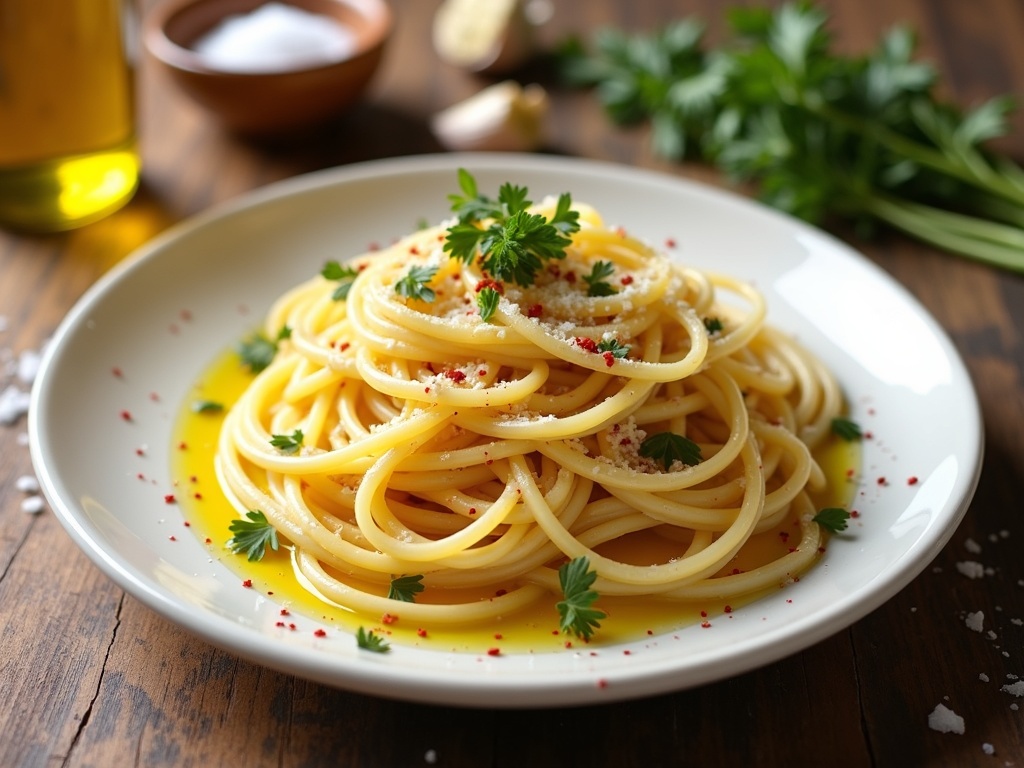
Perfect Your Technique
Creating a flawless aglio olio requires attention to timing and technique. I’ve found that the entire dish comes together in just 20 minutes, making it perfect for busy weeknights when I need a quick yet satisfying meal.
Step-by-Step Process
The foundation of great aglio olio starts with properly cooking the pasta. I always salt my water generously—about 1 tablespoon per gallon—to infuse the spaghetti with flavor from the inside out. The pasta should cook for 8-10 minutes until it reaches that ideal al dente texture, where it still offers a slight resistance when bitten.
While the pasta cooks, I focus on preparing the aromatic base. Here’s my process for the perfect garlic infusion:
- Sauté thinly sliced garlic in olive oil for exactly 2 minutes until golden (not brown) to release its sweetness without developing bitterness.
- Add red pepper flakes and cook for just 30 seconds to bloom their heat and flavor.
- Remove from high heat immediately to prevent burning these delicate ingredients.
A crucial technique I’ve mastered is saving some pasta water before draining. This starchy liquid is the secret to creating that silky emulsion that coats each strand. I typically reserve about 1/2 cup.
After draining the pasta, I immediately toss it with the garlic-infused oil, adding splashes of the reserved pasta water as needed to achieve the perfect consistency. The starch in the water helps the oil cling to the pasta creating a light creamy coating without actual cream.
The final touch comes from freshly chopped parsley, which I sprinkle generously over the dish just before serving. This adds brightness and color that balances the rich garlic and heat from the pepper flakes.
For an extra layer of flavor, I sometimes finish with a sprinkle of high-quality Parmesan, though purists might argue this isn’t traditional. I’ve also found that adding blanched broccoli turns this simple pasta into a more complete meal without compromising its beautiful simplicity.
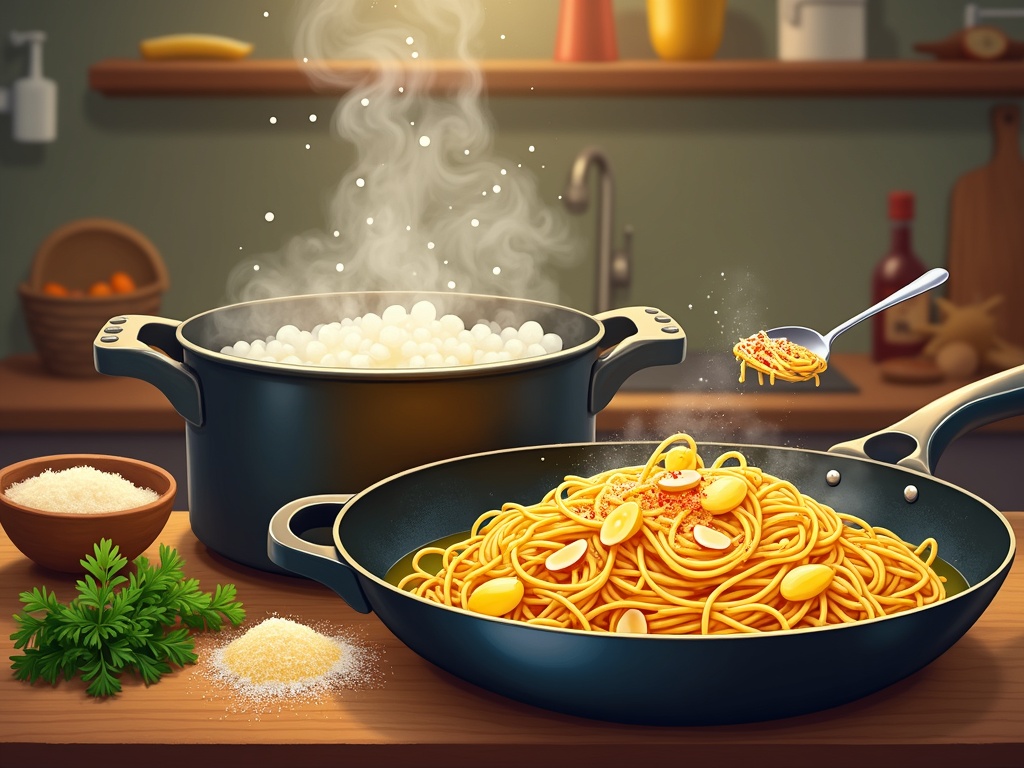
Classic Variations to Try
The beauty of aglio olio lies in its simplicity and versatility. I’ve found that this Italian classic serves as a perfect canvas for creative adaptations while maintaining its essence. After mastering the basic recipe, you’ll want to explore these delicious variations that add new dimensions to this beloved pasta dish.
Traditional and Protein-Rich Options
Aglio Olio e Peperoncino represents the most authentic iteration of this dish. Simply increase the amount of red pepper flakes to create a spicier kick that balances perfectly with the garlic and olive oil base. This small adjustment transforms the flavor profile while staying true to Italian culinary traditions.
Seafood makes an exceptional addition to aglio olio. I particularly enjoy incorporating sautéed shrimp that’s been quickly cooked with a touch of the same garlic-infused oil used for the pasta. The sweetness of the shrimp complements the garlicky pasta beautifully, creating a more substantial yet still elegant dish.
For those wanting a heartier meal, adding protein like chicken works wonderfully. Simply slice and sauté chicken breast until golden, then toss with your finished aglio olio. This adaptation turns a simple side into a complete main course that’s both satisfying and flavorful. You might also enjoy trying it with:
- Grilled chicken strips marinated in lemon and herbs
- Pan-seared tofu cubes for a plant-based protein option
- Sautéed mushrooms for a meaty texture without actual meat
- Crispy pancetta or bacon bits for a savory touch (similar to carbonara but lighter)
Fresh and Vibrant Additions
Vegetarian variations offer endless possibilities by incorporating seasonal vegetables. In summer, I love adding cherry tomatoes that burst with sweetness when lightly sautéed with the garlic. Winter vegetables like broccoli florets or Brussels sprouts add texture and nutritional value. Just blanch them briefly before tossing with the pasta to maintain their vibrant color and bite.
A citrus twist takes aglio olio to new heights. Adding fresh lemon zest and a squeeze of juice just before serving brightens the entire dish with minimal effort. This variation pairs exceptionally well with seafood versions and cuts through the richness of the olive oil base. For an even more pronounced Mediterranean flavor, try incorporating:
- A handful of fresh herbs like basil, parsley, or mint
- Toasted pine nuts or walnuts for crunch
- Sun-dried tomatoes for concentrated flavor
- Olives and capers for a puttanesca-inspired twist
The best part about these variations is how they adapt to different dietary preferences. Most can be made gluten-free by substituting regular pasta with rice or corn-based alternatives. For those following a plant-based diet, the vegetable-forward versions shine without any animal products. Even pesto lovers can find common ground by adding a small spoonful of basil pesto to their aglio olio.
Don’t be afraid to combine these variations either. A seafood aglio olio with lemon and fresh herbs creates a restaurant-worthy dish with minimal effort. The key to success with any variation is maintaining the proper balance—the garlic and olive oil should always remain the foundation that ties everything together.
Health Benefits and Nutrition
Aglio olio pasta offers a surprisingly well-rounded nutritional profile for such a simple dish. Each serving (about 1/4 of the recipe) contains approximately 450 calories, making it a satisfying main course that won’t overwhelm your daily caloric intake.
Nutritional Breakdown
The 20g of total fat per serving (with only 3g being saturated fat) comes primarily from the olive oil, which provides heart-healthy monounsaturated fats. These fats can help reduce bad cholesterol levels and provide anti-inflammatory benefits. The dish delivers 60g of carbohydrates, giving you sustained energy throughout the day, while the 3g of fiber supports digestive health. With 12g of protein per serving, this simple pasta dish helps with muscle maintenance and satiety.
Customizing for Additional Benefits
I’ve found that aglio olio pasta serves as an excellent foundation for additional nutritious ingredients. To boost the nutritional value, consider these healthy additions:
- Colorful vegetables: Adding cherry tomatoes, spinach, or fresh broccoli florets increases vitamin content and fiber
- Lean proteins: Incorporating grilled chicken similar to pesto chicken pasta or seafood can double the protein content
- Nuts and seeds: Toasted pine nuts or pumpkin seeds add texture and healthy fats
- Fresh herbs: Basil or parsley contribute antioxidants and enhance flavor
The beauty of aglio olio lies in its versatility. The base recipe is relatively light compared to creamy white sauce pasta alternatives, making it easier to fit into various dietary plans. By skipping cream and butter found in dishes like chicken carbonara, you save on saturated fat while still enjoying a flavorful meal.
For those looking to add bolder flavors while maintaining the health profile, consider adapting techniques from puttanesca recipes by adding capers or olives, which provide additional micronutrients without significantly increasing the calorie count.
What I appreciate most about aglio olio is how it demonstrates that nutritious eating doesn’t require complicated ingredients or techniques. This classic dish proves that simple, quality ingredients can create both satisfying flavors and a balanced nutritional profile.
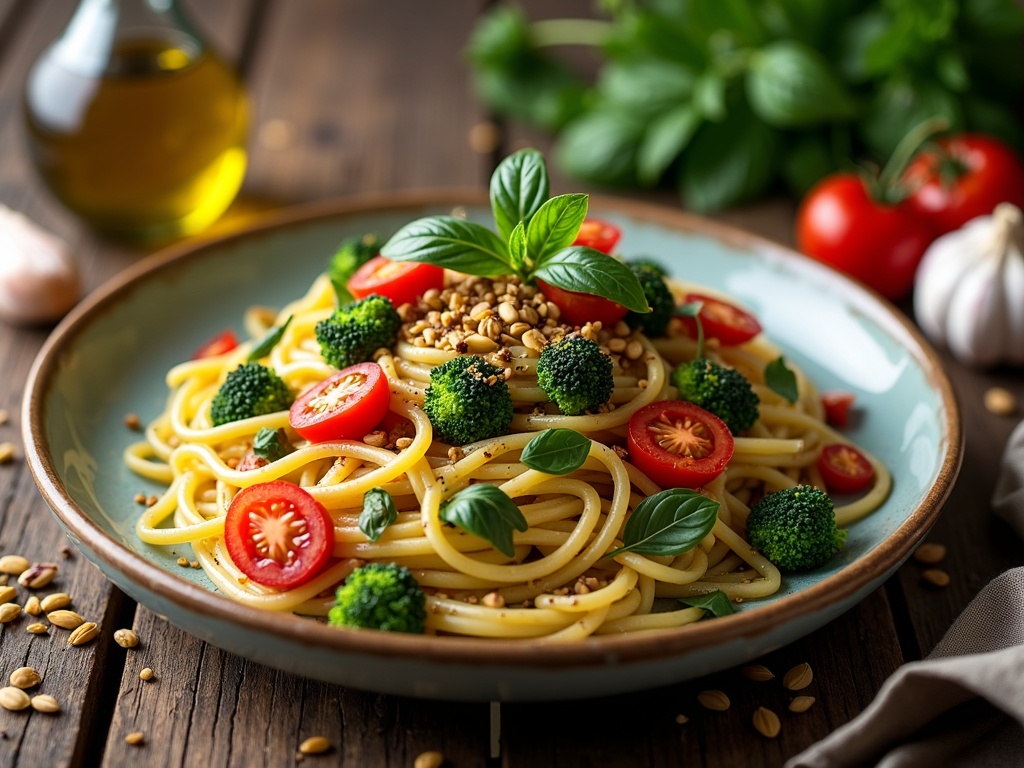
Elevate Your Dining Experience
Freshly prepared aglio olio truly shines when presentation and pairings are thoughtfully considered. I’ve found that serving this classic pasta dish immediately after cooking makes a remarkable difference in the overall dining experience.
Perfect Serving Suggestions
Transferring the pasta to pre-warmed bowls helps maintain that ideal temperature while allowing the delicate flavors to shine. The subtle heat from the warm bowls keeps the olive oil in its most aromatic state, releasing those wonderful garlic notes with each twirl of your fork.
I like to balance the simplicity of aglio olio with complementary side dishes. A crisp green salad with a light vinaigrette creates the perfect contrast to the rich, garlicky pasta. The refreshing crunch and acidity cut through the olive oil, cleansing the palate between bites of the delicious pasta creation.
For an extra touch of indulgence, freshly baked garlic bread makes an irresistible accompaniment. The additional garlic notes echo the pasta’s flavors while providing a satisfying vehicle for soaking up any remaining olive oil and herbs from your plate.
When considering beverages, I recommend pairing this dish with a chilled glass of juice. The bright acidity and fruit notes in these drinks complement the herbal pasta flavors beautifully while cleansing the palate between bites. If you prefer non-alcoholic options, a sparkling water with a squeeze of lemon works wonderfully.
What makes aglio olio so versatile is its ability to transition seamlessly between casual weeknight dinners and more elegant entertaining scenarios. For everyday meals, I serve it family-style in a large bowl, encouraging seconds. For special occasions, I plate individual portions with careful attention to presentation, perhaps adding a fresh herb garnish or a light dusting of high-quality cheese.
The beauty of this dish lies in its adaptability. Whether you’re enjoying a quiet dinner alone or hosting friends for an Italian-inspired gathering, aglio olio delivers sophistication without complexity. Its elegant simplicity makes an impression regardless of the setting, proving that sometimes the most basic ingredients create the most memorable meals.
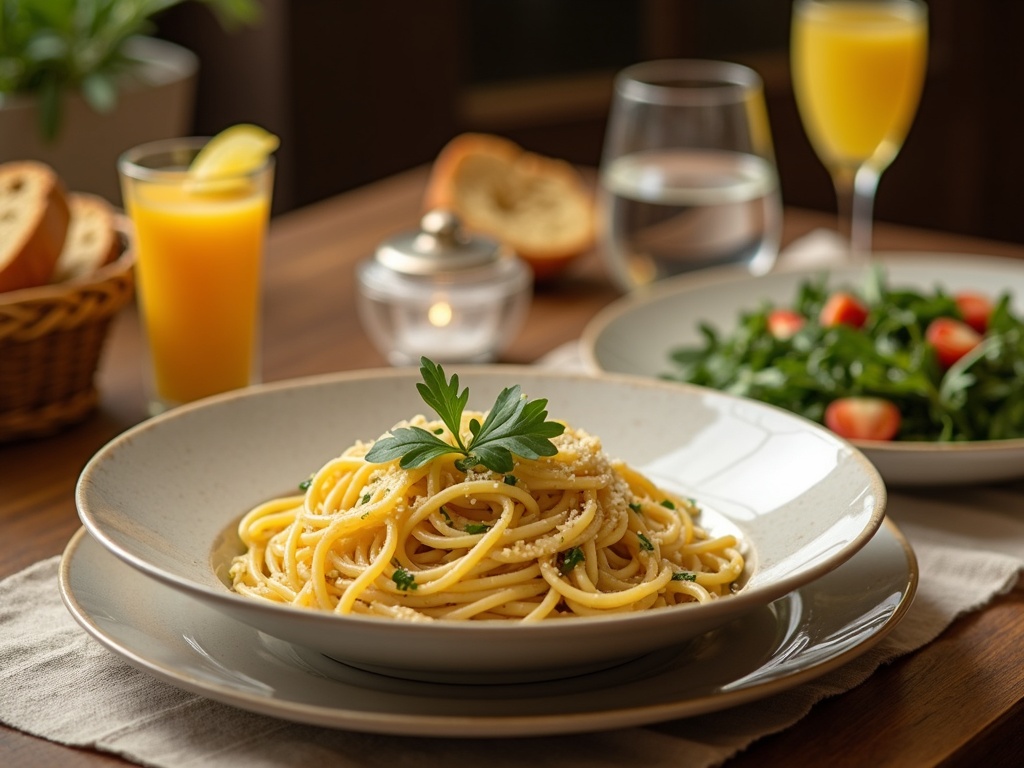
Sources:
“The Complete Italian Cookbook,” Italian Culinary Institute
“Nutritional Composition of Spaghetti,” USDA FoodData Central
“Perfecting Aglio Olio: A Guide,” Culinary Science Journal

